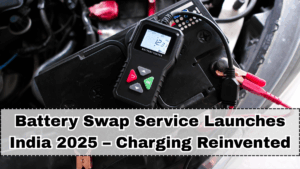India’s EV ecosystem is heading toward a major revolution as New Car Battery Swapping Service Launches India 2025 introduce fast, efficient, and convenient alternatives to traditional charging. Battery swapping eliminates the waiting time associated with EV charging by allowing drivers to replace their depleted battery with a fully charged one in just a few minutes. As India rapidly increases EV adoption, swapping solutions are becoming a powerful option for taxis, fleet operators, delivery services, and even private EV users who want quick turnaround times.
Battery swapping will play a crucial role in the future of battery swap service India 2025 because it solves key pain points: slow charging, range anxiety, and limited charging infrastructure. With standardized battery packs, automated swap stations, and subscription-based services, swapping ensures EVs stay on the road longer. In 2025, automakers, energy companies, and startups will collaborate to introduce smart swap stations, AI-based power management, and modular battery designs across India’s major cities.

Top Battery Swapping Services Launching in 2025
1. NIO Power India – Premium Automated Swap Stations
NIO is expected to bring its globally successful Power Swap Station technology to India. With automatic lifting, battery replacement, and cloud monitoring, it delivers the world’s fastest EV swapping.
Key Highlights:
• Swap time: Under 5 minutes
• Automation: Fully automated
• Monitoring: Real-time diagnostics
USP: Premium EV swap tech for high-end EVs
2. SUN Mobility Mega Swap Network – India’s Largest EV Swap Platform
SUN Mobility is expanding aggressively in 2025 with new stations for cars, autos, and small commercial vehicles.
Key Highlights:
• Modular batteries
• Pay-per-swap plans
• Widest city coverage
USP: Most accessible swap solution across urban India
3. Ola Electric Car Swap Stations – Designed for 2025 EV Models
Ola is preparing swap-ready EVs and stations to support its upcoming electric cars. The focus is on affordability and fast turnaround.
Key Highlights:
• Swap time: 3–5 minutes
• Interface: App-controlled swap
• Fleet-friendly pricing
USP: Best solution for personal + shared mobility users
4. Gogoro India Swap Grid – Two-Wheeler + Car Expansion
Gogoro, known for its two-wheeler swap network, is expanding into small EV cars and urban mobility pods.
Key Highlights:
• Smart battery lockers
• Subscription-based usage
• Energy reserve indicators
USP: Smart, compact swap tech for metros
5. ChargeUp Plus Car Swap Stations – Fleet-Focused Battery Exchange
ChargeUp will introduce swap systems for electric taxis and corporate fleets that rely on high daily usage.
Key Highlights:
• Cost-effective fleet plans
• Auto-lock safety system
• Battery lifecycle optimization
USP: Best option for commercial operators
Why Battery Swapping Is Transforming EV Mobility
Battery swapping offers unmatched convenience, especially for users who cannot wait 45–60 minutes for fast charging. It solves key mobility challenges by making EV usage faster, predictable, and more accessible.
Benefits of the EV swap India trend:
• Zero downtime — swap in minutes
• Lower upfront cost of EVs
• Predictable monthly battery subscription
• Increased range confidence
• Perfect for fleet operators
• No need for home charging setups
This model is especially useful for city driving where frequent usage demands quick battery turnaround.
Technology Behind Modern Battery Swap Systems
Battery swapping relies on intelligent hardware-software integration to ensure safety, efficiency, and performance.
Key technologies:
• Automated robotic swap arms
• Cloud-based battery monitoring
• Modular battery architecture
• AI-driven charge cycle optimization
• Smart lockers with temperature control
These innovations ensure that every swapped battery maintains high health, correct temperature, and stable output.
Cost, Range & Efficiency Improvements
Battery swap systems significantly reduce EV costs because users no longer buy the battery upfront. Instead, they subscribe to a monthly plan and access fully charged batteries whenever needed.
Performance advantages:
• Consistent range with fresh batteries
• Reduced battery degradation
• Improved uptime for commercial fleets
• Better overall energy management
Swapping also enables revenue-sharing models between power companies, automakers, and fleet operators.
Why 2025 Will Be the Breakthrough Year
The rise of EV sales, government support for swapping infrastructure, and collaborations between automakers and energy companies position 2025 as the year battery swapping becomes mainstream. As more compatible EVs enter the market and swap stations increase across cities, users will gain the confidence to choose swapping over traditional charging.
FAQs
How fast is battery swapping?
Most stations allow full swapping in 3–5 minutes.
Is swapping cheaper than charging?
Yes, subscription-based swap plans often reduce monthly energy costs.
Will all EVs support swapping?
Only models designed with standardized battery packs can use swap stations.
Does swapping affect battery life?
No, cloud-managed charging ensures optimal battery health and longevity.
Is swapping available in all cities?
Initial rollout will focus on metros, expanding to Tier-2 cities by late 2025.
Click here to know more.
